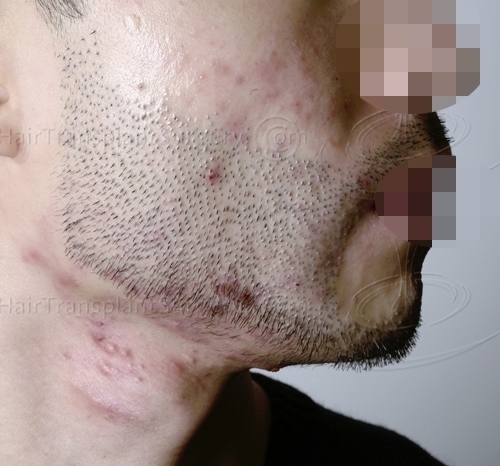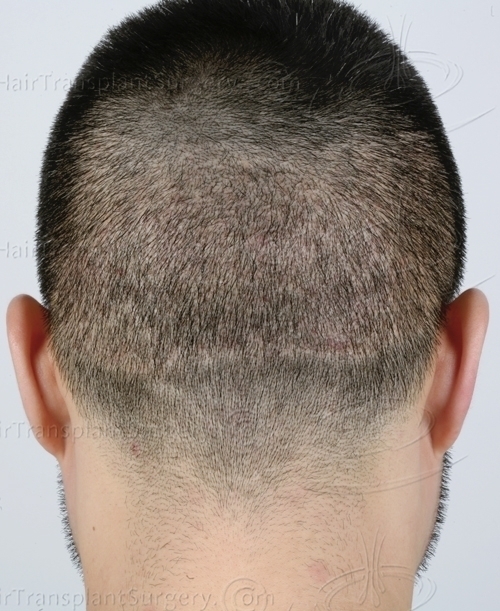In 2017, this patient traveled to hospital in Istanbul for a beard transplant. His experience was disastrous. It has taken him a lot of time, cost, and pain to fix the near irreparable damage that – for a time – he believed had permanently ruined his face. He booked his procedure through a travel medical agency; through them, they arranged for him to go to the hospital in Turkey.

The surgery costed less than 2000€ and consisted in a 1500 grafts FUE (though, based on the pictures, they probably extracted more grafts and overharvested his donor area); the grafts were extracted from the scalp and implanted onto his cheeks.
No doctors performed the actual procedure itself. Such is the case for the majority of hair transplant surgeries in Turkey, which is illegal and breaks Turkish laws. In this kind of clinics, the most involvement you’ll see from a Turkish doctor is that he will draw your hairline with a marker before leaving other unqualified staff to handle the rest of the transplant. When the procedure started, all the doctors were in the room with him. After receiving the anesthesia shots, he relaxed and fell asleep. When he woke up later on, he realized that all the doctors had left the room and only two technician girls (for whom he know nothing of their qualification) were left to carry out the entire thing. The poor technique employed resulted in an extremely fake appearance.
PICTURES BEFORE REPAIR sURGERY





This case study was presented by Jean Devroye, MD, FISHRS
If you ask any respectable hair transplant doctor, he will tell you that there should be no more than 1-2 hairs per graft maximum. As the patient has extremely thick and coarse hair, most doctors would know to cut the hair extracted from the head into finer pieces before transplanting. But this was not done for him in Turkey and the result was an extremely fake looking beard with grafts that were too thick (some even had 4-5 hairs in a single graft).
In addition, the artistry and workmanship were totally lacking. As you can see in the pictures, there are clear telltale signs that made his beard look fake: hairline across cheeks too straight; two extremely bare circles on the chin; unsymmetrical, uneven moustache; hair growing in wrong direction; texture too thick for facial hair. Any hair transplant procedure is highly labor-intensive, dependent on the artistry and workmanship of your doctor. After extraction from your head and then cutting those hairs into fine, single hair grafts, they have to be planted at a certain angle depending on the part of your face so they grow in a natural direction. They also can’t be shoved too deep into the skin. Unfortunately, the patient received none of this.
As a result, he experienced the worst skin problems. He developed severe acne and folliculitis because the hair grafts had been shoved too deeply into his skin. He developed pitting and cobblestoning as well, which is a condition where you can see the skin is raised on each hair graft. This was because the hair they transplanted was too thick and each piece was sticking out of the follicle, almost falling out. With constantly irritated skin, it only made his beard look more fake. What was worst was when he realized they had damaged his donor area as well. What was initially only meant to be an extraction of 1,500 grafts turned out to be significantly more. This clinic (as with most others in Turkey) took far more grafts from his donor zone in one day than any reputable clinic would consider to be safe. Where he had no previous issues with hair thinness or balding, they overharvested and scarred the back of his head creating a new problem.
Because of this, he became so insecure about it that he would always enter a room with his back against a wall so nobody would see it. Compared to the subsequent corrective hair transplants he received later, the recovery from this procedure was also really bad: he could not go outside home for more than 10 days, because his appearance was horrible. He had bruising on his face, the transplanted hairs looked really bad, and the donor area on the back of his head was severely scarred. In comparison, his corrective surgeries in Belgium only took a couple of days before it looked more or less healed (it was 4 full days exactly before everything was almost 100%).
PICTURES AFTER REPAIR SURGERY









It has taken him a long time and significantly additional costs in order to find Dr. Devroye. When he found him he was truly relieved as he is one of the best in the field of hair transplantation, which is why he came to Belgium for this. He is a true subject matter expert when it comes to all things hair-related. In working with him, he has found Dr. Devroye to be extremely passionate and dedicated, putting countless hours to work late and take care of his patients. Early on, Dr. Devroye helped him realize that it is very difficult to “undo” a hair transplant and the solution is never straightforward in such a situation.
At best, you can only hope to fix as much as possible and then camouflage the existing issues. Moreover, it has been an extremely painful process because of the scarring created in Turkey (the scarring means that any injections or transplanting to the donor or recipient areas will hurt more). In his sessions so far (the first being a small test in order to confirm the viability of the corrective procedure) Dr. Devroye has essentially combed through his beard with a magnifying glass and removed all the problematic hairs (which was around 90% of them). He cut them and replanted the beard hairs at a correct angle with the correct depth. All leftover hairs were put back into his donor area to fix the thinness, baldness, and scarring. In a 2-day period, Dr. Devroye and his team worked with 2,700 grafts. Amazingly, his skin cleared up right away and all the folliculitis, acne, and pitting problem went away almost instantly. Appearance-wise, his beard looks really natural now with finer hairs, more natural hairlines with synchronicity.